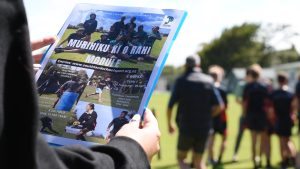Traditional Māori sport proving popular for Southland youth

A traditional Māori sport is securing its place among mainstream sports in Murihiku Southland, thanks to local organisations looking to support the aspirations of rangatahi Māori.
Kī-o-rahi has proven popular across Waihōpai (Invercargill) and the wider region, with around 14 secondary school teams and 10 primary school teams participating in a new interschool tournament.
The sport was identified by rangatahi as a way to better connect young people to te ao Māori. The rangatahi, who lead Te Rourou, One Aotearoa Foundation’s Te Ōhaka Tīwhera fund, decided to create Kā Taoka I Tuku Iho Charitable Trust to support Māori sports in Murihiku.
“Kī-o-rahi was already popular with our rangatahi Māori, but they wanted to see it grow. They didn’t just want to play once a year to celebrate Matariki, they wanted it to be a regular option for everyone, alongside rugby and basketball,” Te Rourou, Community Catalyst Mandy Smith said.
“They decided they wanted to create the trust and allocate some funds to kickstart it. They made all of the decisions, and the community fully backed them. We see it as a huge step forward in elevating rangatahi voice and supporting Māori aspirations.”
A collaboration between Kā Taoka and Active Southland was soon formed which saw the game spreading far and wide.
“It grew much more quickly than we expected it to,” Active Southland Rangatahi Advisor Greg Houkamau said.
“It’s been really surprising for the team how fast it has grown; it’s just taken off. It’s a fun sport, everybody’s got a role to play, and it introduces te ao Māori concepts, and te reo Māori in a fun way.”
Kā Taoka has the potential to affect big impact on Māori sport and further supporting rangatahi, he said.
“It’s something we are already expanding on, including looking at bringing in tapu ae. For me, I’m learning as well, and just getting amazing feedback from our rangatahi and our hapori as well.”
“Our priority for 2024 is amplification and how we integrate it into curriculum. That integration is critical.”
